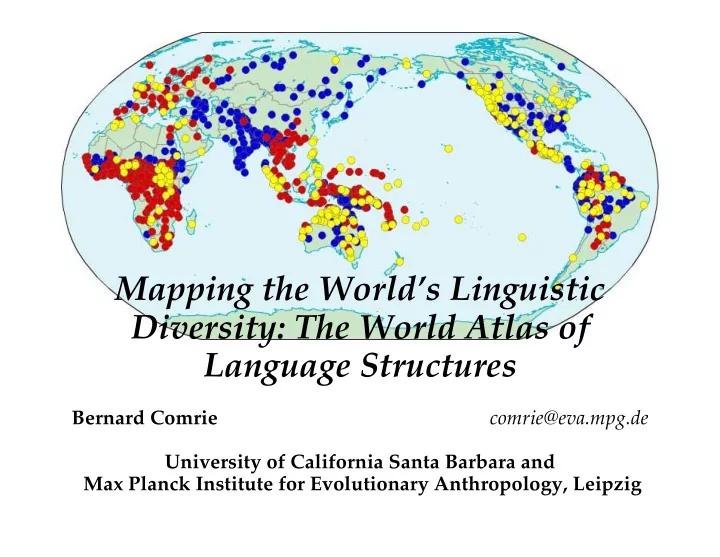

Mapping the World’s Linguistic Diversity: The World Atlas of Language Structures Bernard Comrie comrie@eva.mpg.de University of California Santa Barbara and Max Planck Institute for Evolutionary Anthropology, Leipzig
The World Atlas of Language Structures (WALS) edited by Martin Haspelmath, Matthew S. Dryer , David Gil, and Bernard Comrie Interactive Reference Tool by Hans-Jörg Bibiko Oxford: Oxford University Press, 2005, 695 pages a five-year project at the Department of Linguistics, Max Planck Institute for Evolutionary Anthropology (MPI-EVA), Leipzig (1999-2004)
wals.info
Genealogical (genetic) diversity English belongs to the Germanic branch of the Indo-European language family.
Source: http://en.wikipedia.org/wiki/Indo-European_languages (2012 March 06)
Arabic belongs to the Semitic branch of the Afroasiatic language family.
Source: http://en.wikipedia.org/wiki/Afroasiatic_languages (2012 March 06)
Structural diversity
Tone Chinese (Mandarin): 4 tones m ā ‘mother’ má ‘hemp’ m ǎ ‘horse’ mà ‘reproach’
Gender Spanish: 2 genders (masculine el , feminine la ‘the’) el chico ‘the boy’ la chica ‘the girl’ el árbol ‘the tree’ la casa ‘the house‘ German: 3 genders (masculine der , feminine die , neuter das ‘the’) der Mann ‘the man’ die Frau ‘the woman’ der Löffel ‘the spoon’ die Gabel ‘the fork’ das Messer ‘the knife’
Order of object and verb English: V O The student bought the book. V O Japanese: O V Gakusei ga hon o katta. O V
Words for ‘arm’/‘hand’ English: differentiation arm hand Russian: identity ruká
Representation of languages in WALS
Preliminary remarks About 6-7,000 languages are spoken in the world today; most are endangered, in 100 years we will be lucky to find half this number. Most of these languages have very few speakers: fewer than 400 have over a million speakers; nearly 4,000 have fewer than 10,000 speakers. WALS presents data on a sample of these languages, using an ideally fixed sample of 200 languages, supplemented by other languages according to convenience.
Most of these languages are spoken in small communities, in traditional locations, and can be readily represented by a dot on a map. We extend this practice to ALL languages, taking various practical decisions, e.g. “undoing” recent migrations; so: English is spoken in England. Spanish is spoken in Spain. Zoogocho Zapotec is spoken in San Bartolomé Zoogocho (Oaxaca).
Feature values are represented by the color of the dot
[Main areas: Southeast Asia; equatorial Africa]
[Black dots in Africa mainly Niger-Congo languages.]
Correlations Between Features
Relative clauses English: N Rel (the) book [that the student bought] N Rel Japanese: Rel N [gakusei ga katta] hon Rel N
Hypotheses: a) VO order tends to correlate with NRel order. b) OV order tends to correlate with RelN order
Correlation between VO/OV and NRel/RelN order Combination Languages VO & NRel 370 VO & RelN 5 OV & RelN 109 OV & NRel 96
Hypotheses: a) VO order tends to correlate with NRel order 370 : 5 strongly confirmed only 5 exceptions, all in China b) OV order tends to correlate with RelN order 109 : 96 not confirmed confirmatory instances concentrated in Asia
Hand and arm
Hypothesis: Non-differentiation of ‘hand’ and ‘arm’ terms is more likely closer to the equator, differentiation more likely further from the equator. Latitude Differentiation Identity 70°N–36°N, 10°S–55°S 231 60 35°59´N–9°59´S 158 168 gamma = .61 p < .001 N = 617
Relatives and Neighbors To what extent do languages tend to be similar structurally a) to their relatives? genealogical basis b) to their neighbors? areal basis Test case: (Mainland) Southeast Asia
Numeral classifiers English two dogs Vietnamese hai con chó two CL dog
20 diagnostic features of Southeast Asian languages Percentage of features shared by selected languages (NB: Not all data complete)
Mongolian 5 Mandarin 42 Hmong Njua 64 Burmese Thai Vietnamese 50 95 89 Khmer 85 Malay-Indonesian 65
Mapping the World’s Linguistic Diversity: The World Atlas of Language Structures Bernard Comrie comrie@eva.mpg.de University of California Santa Barbara and Max Planck Institute for Evolutionary Anthropology, Leipzig
Recommend
More recommend